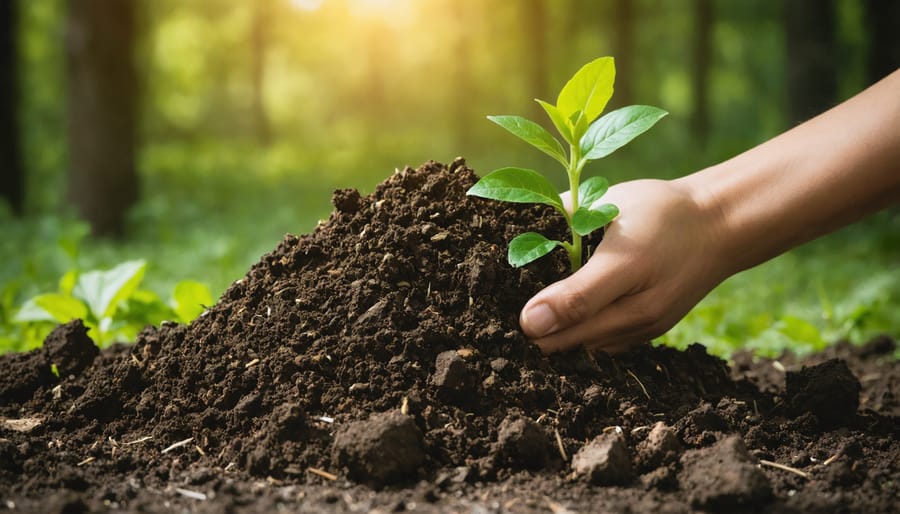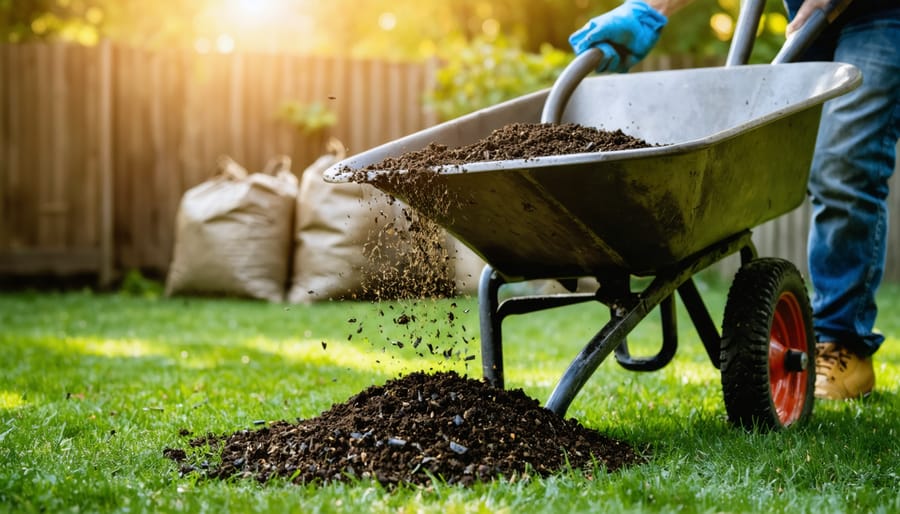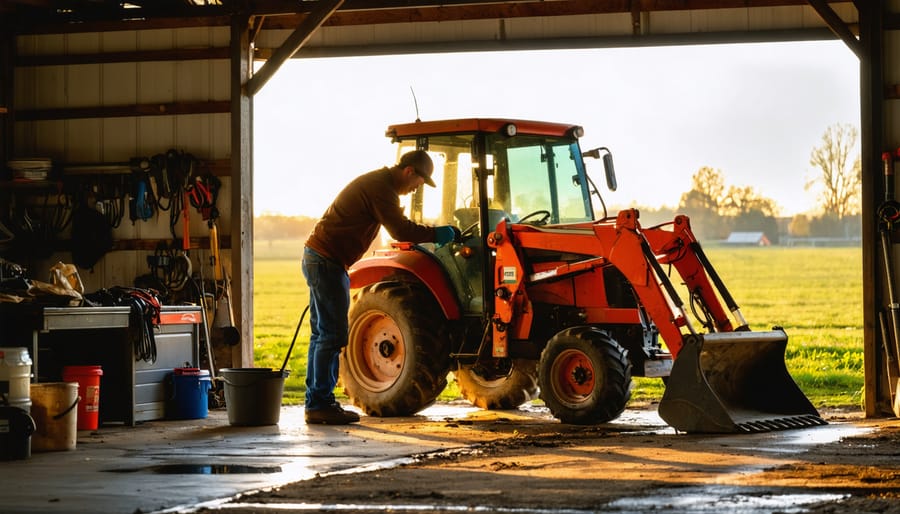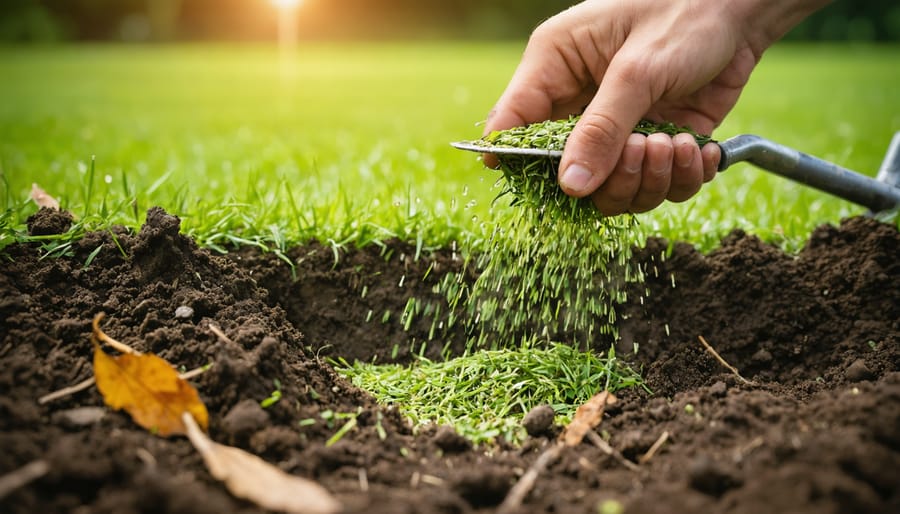Look for the Seal of Testing Assurance (STA) certification from the US Composting Council when shopping for bagged compost at your local garden center. This voluntary testing program verifies that compost products meet strict quality standards for maturity, stability, and nutrient content, giving you confidence that what you’re spreading on your lawn won’t burn grass roots or introduce weed seeds. The USCC, founded in 1990, serves as the composting industry’s leading voice and sets science-based standards that help separate premium products from subpar alternatives.
Check product labels for USCC participation marks before purchasing, as certified composts undergo rigorous laboratory testing for physical contaminants, salts, pH levels, and organic matter content. These standards matter because poorly processed compost can actually harm your lawn by tying up nitrogen during decomposition or introducing pathogens. When you understand how compost benefits your lawn, you’ll want assurance that your investment delivers results.
Request test reports from bulk compost suppliers who claim USCC affiliation, particularly when ordering large quantities for lawn renovation projects. Reputable producers willingly share documentation showing their products meet or exceed USCC guidelines for particle size, moisture content, and carbon-to-nitrogen ratios. This transparency protects your lawn investment and supports companies committed to producing environmentally responsible soil amendments that truly improve grass health and soil biology.
What Exactly Is the US Composting Council?
If you’ve ever wondered who decides whether that bag of compost at your local garden center is actually worth buying, let me introduce you to the US Composting Council. Think of them as the trusted watchdog of the composting world, and honestly, they’re doing pretty important work that affects every gardener who uses compost in their yard.
Founded in 1991, the USCC is a nonprofit organization that serves as North America’s leading authority on all things composting. Their mission goes beyond just promoting composting, though that’s certainly part of it. They’ve taken on the essential task of creating and maintaining standards that help us identify quality compost from the not-so-great stuff. This matters more than you might think when you’re investing time and money into improving your lawn and garden soil.
What makes the USCC particularly valuable for homeowners like us is their role in education and certification. They’ve developed testing protocols and certification programs that help compost producers demonstrate their products meet specific quality standards. When you see a product bearing the USCC Seal of Testing Assurance, you know it’s been independently tested for things like maturity, stability, and nutrient content. No more guessing games at the garden center.
The Council also works to advance composting knowledge through research, training programs, and their annual conferences where composting professionals share the latest innovations. While you probably won’t attend these events yourself, the science and best practices that emerge from them eventually trickle down to better products and information available to home gardeners.
For those of us passionate about sustainable gardening practices, the USCC represents a bridge between large-scale composting operations and our backyard gardens. They’re essentially translating complex science into practical standards that protect both our gardens and the environment. Their work ensures that when we choose compost as an eco-friendly soil amendment, we’re getting products that actually deliver the benefits we’re counting on for healthier lawns and thriving plants.

How USCC Standards Protect Your Lawn and Garden
The Seal of Testing Assurance (STA) Program
When you’re shopping for compost to use in your vegetable garden or on your lawn, you want to know it’s actually safe and effective, right? That’s exactly where the Seal of Testing Assurance (STA) Program comes in. Think of it as a quality stamp that tells you the compost you’re buying has been rigorously tested and meets strict safety standards.
The STA certification isn’t just handed out freely. Products bearing this seal have undergone comprehensive laboratory testing for three critical factors. First, they’re checked for pathogens like E. coli and Salmonella, which is especially important if you’re growing tomatoes, lettuce, or other edibles that might come into contact with the soil. Second, the compost is analyzed for heavy metals like lead, cadmium, and mercury. These contaminants can accumulate in soil over time and potentially transfer into your plants, so keeping them at safe levels matters tremendously. Third, the testing evaluates maturity and stability, meaning the compost has fully broken down and won’t rob your plants of nitrogen as it continues decomposing in your garden beds.
Why should this certification influence your purchasing decisions? Here’s the practical reality: not all compost is created equal. Some products might look dark and crumbly but could contain harmful bacteria or excessive metals that compromise your soil health over years of use. For your edible garden, using STA-certified compost gives you peace of mind that you’re not introducing contaminants into food your family will eat. For your lawn, it ensures you’re building healthy soil that supports robust grass growth without hidden risks. When you see that STA seal, you know independent testing has verified the product meets rigorous standards established by composting experts.

Understanding Compost Quality Standards
When you’re shopping for compost or evaluating what you’ve been working with in your garden, understanding what makes quality compost can feel a bit like reading tea leaves. Thankfully, the USCC takes the guesswork out by establishing clear benchmarks that help ensure you’re getting the good stuff for your lawn and garden beds.
Let’s break down the main quality indicators that matter most. First up is particle size, which refers to how finely the compost is screened. Think of it like choosing between coarse sand and fine powder. Smaller particles integrate more smoothly into your soil and provide better surface contact with plant roots, though coarser compost works wonderfully as mulch. Most quality compost falls in the half-inch to three-quarter-inch range, striking a nice balance for general lawn and garden use.
Moisture content is another critical factor. Properly finished compost should feel like a wrung-out sponge, moist but not dripping. Too wet, and you’re essentially paying for water weight while risking anaerobic conditions that create unpleasant odors. Too dry, and beneficial microorganisms become less active, slowing down soil improvement.
Organic matter content tells you how much actual carbon-based material remains to feed your soil ecosystem. Quality compost typically contains 30-65% organic matter, which gradually breaks down to improve soil structure and water retention. This is what transforms hard clay or sandy soil into that dreamy, crumbly texture we all want.
Finally, nutrient levels matter, though compost isn’t necessarily a high-powered fertilizer. Instead, think of it as a slow-release multivitamin for your lawn. The USCC monitors nitrogen, phosphorus, and potassium ratios to ensure balanced nutrition that supports steady, healthy growth without the feast-or-famine cycles that synthetic fertilizers sometimes create.
Building Better Soil Health Through USCC-Approved Practices
Soil Structure and Water Management Benefits
Think of compost as nature’s soil conditioner, and you’ll quickly understand why USCC-certified compost is such a game-changer for your lawn. When you work quality compost into your soil, something remarkable happens beneath the surface. The organic matter acts like tiny construction workers, binding soil particles together into stable aggregates. These crumb-like structures create space for air and water to move freely, which is exactly what grass roots crave.
If you’ve ever tried to dig into compacted clay soil that’s hard as concrete, you know the struggle is real. Proper compost application transforms that challenging environment. The organic materials physically break up dense soil while encouraging beneficial microorganisms that further improve soil structure. Over time, even the most stubborn compacted areas become softer and more workable.
The water management benefits are where compost really shines. Those improved soil aggregates work like tiny sponges, holding moisture during dry spells while still allowing excess water to drain away during heavy rains. This means fewer puddles after storms and less stress on your grass during summer droughts. Many gardeners find that incorporating quality compost complements their water retention strategies beautifully, reducing the need for frequent irrigation while keeping lawns healthier.
The best part? These benefits build over time. Each compost application continues improving your soil structure, creating a more resilient lawn that can weather whatever Mother Nature throws its way.

Nurturing the Soil Food Web
Think of your soil as a bustling underground city, teeming with life that works around the clock to keep your plants healthy. When you add quality compost certified by the US Composting Council, you’re essentially importing beneficial residents to this microscopic metropolis. These hardworking microorganisms, including bacteria, fungi, and protozoa, create what experts call the soil food web, a natural system that delivers nutrients to your plants more effectively than any chemical fertilizer could.
Here’s what makes this so exciting for your lawn and garden: these beneficial microbes don’t just sit there. They actively break down organic matter, releasing nitrogen, phosphorus, and other essential nutrients in forms your plants can actually absorb. It’s like having a team of tiny chefs constantly preparing customized meals for your grass and plants. Even better, many of these microorganisms produce natural antibiotics and enzymes that protect plant roots from diseases and pests.
When you’re transforming your soil with USCC-certified compost, you’re introducing billions of these beneficial organisms in one application. The beauty of this approach is its sustainability. Unlike synthetic fertilizers that provide a quick nutrient boost but do nothing for long-term soil health, compost builds a self-sustaining ecosystem. Over time, you’ll find yourself reaching for the fertilizer bag less frequently as your soil becomes more biologically active and fertile.
The result? Healthier plants with stronger root systems, better drought resistance, and improved resilience against common lawn diseases. You’re not just feeding your plants; you’re creating an environment where they can thrive naturally for years to come.
How to Apply USCC Principles to Your Home Composting

Temperature and Time: Getting It Right
Getting your compost pile to the right temperature is like finding that sweet spot when baking bread – too cool and nothing happens, too hot and you might kill the good stuff along with the bad. According to the US Composting Council guidelines, your pile should reach between 131°F and 170°F to effectively kill pathogens and weed seeds that could otherwise wreak havoc in your garden.
Here’s the practical part: your pile needs to maintain temperatures of at least 131°F for a minimum of three days during the active composting phase. Think of it as a hot yoga session for your organic materials. During this time, those high temperatures are working hard to eliminate harmful bacteria like E. coli and Salmonella, plus they’re cooking those pesky weed seeds so they won’t sprout in your flower beds later.
The total composting process typically takes anywhere from a few weeks to several months, depending on your methods and materials. Hot composting, where you actively manage temperature and turning, speeds things up considerably. If you’re using a more passive approach, just be patient – good things take time, and safe, pathogen-free compost is definitely worth the wait.
A simple compost thermometer, available at most garden centers for under twenty dollars, becomes your best friend here. Check your pile regularly, and when temperatures start dropping, give it a good turn to reintroduce oxygen and restart the heating process. This attention to temperature ensures you’re creating compost that’s not just nutrient-rich, but genuinely safe for your garden and family.
The Right Carbon-to-Nitrogen Balance
Getting the carbon-to-nitrogen ratio right is one of those things that sounds intimidating at first, but honestly, it’s simpler than you might think. The US Composting Council recommends aiming for a ratio of about 25-30 parts carbon (browns) to 1 part nitrogen (greens), but don’t worry about breaking out your calculator. Think of it more as a visual guideline.
Your browns are things like dried leaves, shredded newspaper, cardboard, and wood chips. These carbon-rich materials provide structure and help air circulate through your pile. Greens include fresh grass clippings, vegetable scraps, coffee grounds, and garden trimmings. These nitrogen-rich materials heat up your pile and speed decomposition.
Here’s my go-to method that works beautifully: for every bucket of greens you add, toss in roughly three to four buckets of browns. If your pile starts smelling like ammonia, you’ve got too many greens, so just add more browns. If it’s not heating up or decomposing slowly, add more greens to kick things into gear.
I like to keep a small pile of dried leaves or shredded paper near my compost bin so I can easily balance out kitchen scraps as I add them. This little habit makes a huge difference in how quickly your compost breaks down. Within a few weeks of maintaining this balance, you’ll notice your pile heating up and transforming into that rich, dark gold we’re all after.
Choosing USCC-Certified Compost Products for Your Landscape
When you’re shopping for compost, finding a product with the USCC’s Seal of Testing Assurance (STA) is like having a trusted friend vouch for quality. But navigating the garden center aisle can still feel overwhelming, so let’s break down exactly what to look for.
First, check the label for the distinctive STA logo. This certification means the compost has been tested by an independent laboratory and meets strict quality standards for maturity, stability, and safety. Think of it as a guarantee that you’re not bringing weed seeds, pathogens, or immature materials into your garden beds.
Beyond the certification mark, read the product analysis information. Quality compost labels should list organic matter content (usually 40-65%), moisture levels, and pH. You’ll also see nutrient information like nitrogen, phosphorus, and potassium levels. Don’t worry if these numbers seem lower than synthetic fertilizers – compost works differently, improving soil structure while feeding plants gradually.
To find STA-certified products near you, start with the USCC’s online product directory on their website. Many independent garden centers and landscaping supply companies carry certified products, though they might not always be prominently displayed. Don’t hesitate to ask staff specifically for USCC-certified compost – your question might even encourage them to stock it if they don’t already.
Local municipal composting facilities are another excellent source. Many cities now produce STA-certified compost from yard waste programs, offering it to residents at reasonable prices or even free. This approach supports your community’s sustainability efforts while keeping your gardening costs down.
Remember, quality compost should smell earthy and pleasant, not sour or ammonia-like. It should be dark, crumbly, and relatively uniform in texture. When you’re investing in your soil’s future, certification gives you confidence that you’re making the right choice.
The Environmental Impact: Why USCC’s Work Matters Beyond Your Yard
When you toss kitchen scraps into your compost bin or spread finished compost across your garden beds, you’re participating in something much bigger than improving your own soil. The work championed by the US Composting Council creates ripples that extend far beyond individual yards, addressing some of our planet’s most pressing environmental challenges.
Every year, Americans send millions of tons of organic material to landfills, where it decomposes without oxygen and releases methane, a greenhouse gas 25 times more potent than carbon dioxide. By diverting food scraps, yard waste, and other organic materials to composting facilities instead, we dramatically reduce these harmful emissions. The USCC’s efforts to standardize and promote composting practices help scale this impact across communities nationwide.
Beyond reducing landfill waste, quality compost actively sequesters carbon in the soil. When you incorporate compost into your lawn and garden, you’re essentially locking carbon away rather than allowing it to enter the atmosphere. This process helps combat climate change while simultaneously improving your soil’s health and water retention capacity.
The broader environmental benefits continue from there. Healthier, compost-enriched soils require less irrigation, reducing water consumption in your community. They also minimize the need for synthetic fertilizers, which reduces pollution in local waterways and decreases the carbon footprint associated with manufacturing and transporting these products.
When you choose certified compost products and embrace sustainable landscaping practices, you’re joining a growing movement. Your individual choices, multiplied across thousands of households, create measurable change in waste reduction, carbon sequestration, and ecosystem health. The USCC provides the framework and standards that ensure this collective impact remains effective and scientifically sound, transforming everyday gardening decisions into meaningful environmental action.
Understanding the U.S. Composting Council’s role in setting industry standards truly empowers you to make smarter choices for your lawn and garden. When you know what to look for, like the STA certification seal or testing protocols that guarantee quality, you’re no longer guessing about whether a compost product will deliver results. You’re investing in materials that have been rigorously evaluated for safety, nutrient content, and effectiveness.
As you plan your next gardening project, I encourage you to seek out USCC-certified compost products. Check those labels, ask questions at your local garden center, and don’t hesitate to contact suppliers about their testing practices. These small steps lead to healthier soil, more vibrant plants, and lawns that thrive naturally without excessive chemical inputs.
Remember, sustainable landscaping starts with informed decisions. By applying these principles and choosing quality compost backed by recognized standards, you’re not just improving your own yard. You’re supporting responsible manufacturing practices and contributing to a larger movement toward environmental stewardship. Your garden becomes part of something bigger, turning waste into resources and creating beauty that benefits both your home and the planet.



